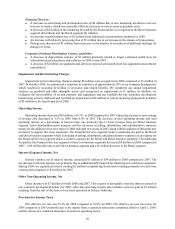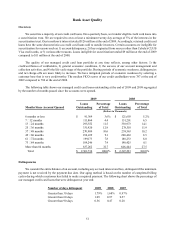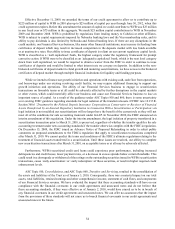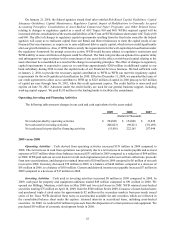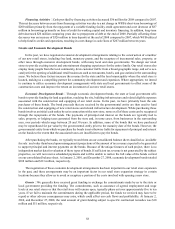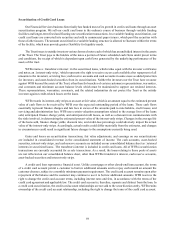Cabela's 2009 Annual Report Download - page 62
Download and view the complete annual report
Please find page 62 of the 2009 Cabela's annual report below. You can navigate through the pages in the report by either clicking on the pages listed below, or by using the keyword search tool below to find specific information within the annual report.53
able to manage our cash needs during peak periods, if any disruption occurred to our funding sources, or if we
underestimated our cash needs, we would be unable to purchase inventory and otherwise conduct our merchandising
business to its maximum effectiveness, which could result in reduced revenue and profits.
Our unsecured $350 million revolving credit facility and unsecured senior notes contain certain financial
covenants, including the maintenance of minimum debt coverage, a fixed-charge coverage ratio, a cash flow leverage
ratio, and a minimum tangible net worth standard. In the event that we failed to comply with these covenants and the
failure to comply would go beyond 30 days, a default would trigger and all principal and outstanding interest would
immediately be due and payable. At January 2, 2010, we were in compliance with all financial covenants under our
credit agreements and unsecured notes. We anticipate that we will continue to be in compliance with all financial
covenants under our credit agreements and unsecured notes through the next 12 months.
In addition, recent and unprecedented distress in the worldwide credit markets has had an adverse impact on
the availability of credit. Although our unsecured $350 million revolving credit facility does not expire until June
2012, continued market deterioration could jeopardize the counterparty obligations of one or more of the banks
participating in our facility, which could have an adverse effect on our business if we are not able to replace such
credit facility or find other sources of liquidity on acceptable terms. We currently expect all participating banks to
provide funding as needed pursuant to the terms of our credit facility.
Financial Services Business Segment (World’s Foremost Bank or “WFB”) – The primary cash requirements
of WFB relate to the financing of credit card loans. These cash requirements will increase if our credit card originations
increase or if our cardholders’ balances or spending increase. WFB sources operating funds in the ordinary course
of business through various financing activities, which includes funding obtained from securitization transactions,
borrowing under its federal funds purchase agreements, obtaining brokered and non-brokered certificates of deposit,
and generating cash from operations. On April 14, 2009, WFB completed a term securitization transaction for $500
million. The most senior class of asset-backed notes issued in that transaction qualified as “eligible collateral”
under the TALF program provided by the Federal Reserve Bank of New York (“FRBNY”). The TALF program is
designed to increase credit availability and support economic activity by facilitating renewed issuance of consumer
and business asset-backed securities at more normal interest rate spreads. Under the TALF program, the FRBNY
provided non-recourse funding to eligible investors who purchased TALF eligible asset-backed notes sponsored
by WFB. No funding was provided directly to WFB. The TALF program will cease making new loans secured by
eligible collateral backed by credit card receivables on March 31, 2010, unless the Board of Governors of the Federal
Reserve System extends the facility. During the term that the TALF facility is making new loans secured by eligible
collateral backed by credit card receivables, WFB will have the ability to sponsor the issuance of additional classes
of TALF eligible asset-backed notes, subject to certain limitations. Among other things, (i) the aggregate amount of
TALF eligible asset-backed notes sponsored by WFB may not exceed the aggregate amount of the asset-backed notes
sponsored by WFB that matured in 2009 or will mature in the first quarter of 2010; (ii) the TALF eligible asset-backed
notes must satisfy the FRBNY’s risk assessment requirements; and (iii) the TALF eligible asset-backed notes must
be rated in the highest long-term or short-term investment-grade rating category by two or more eligible nationally
recognized statistical rating organizations (“NRSROs”) and must not be rated below the highest investment-grade
rating category from any eligible NRSRO or be on review or watch for downgrade by any NRSRO. WFB does not
have any significant continuing obligations under the TALF program, except that under certain circumstances WFB
must notify the FRBNY and investors if the asset-backed notes cease to qualify as eligible collateral under the TALF
program and WFB agrees to provide certain information regarding the asset-backed notes to the FRBNY. On June
5, 2009, the Trust renewed and increased a $214 million variable funding facility to a $260 million variable funding
facility that will mature on June 4, 2010. On September 15, 2009, the Trust renewed and increased a $376 million
variable funding facility to a $412 million variable funding facility that will mature on September 14, 2010. WFB
completed an additional securitization transaction for $300 million on February 12, 2010, under the TALF program.
In addition to this securitization, in 2010 WFB intends to renew its two variable funding facilities, issue additional
certificates of deposits, and receive a capital contribution from Cabela’s. We believe that these liquidity sources are
sufficient to fund WFB’s foreseeable cash requirements and near-term growth plans.









